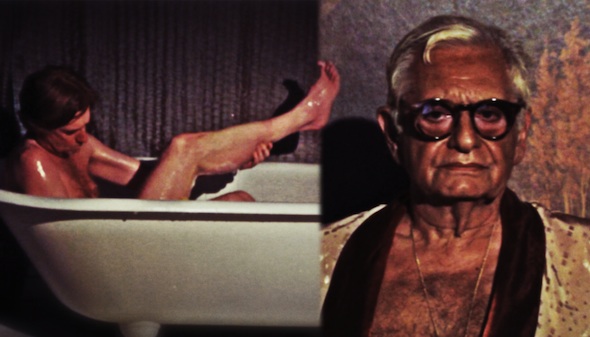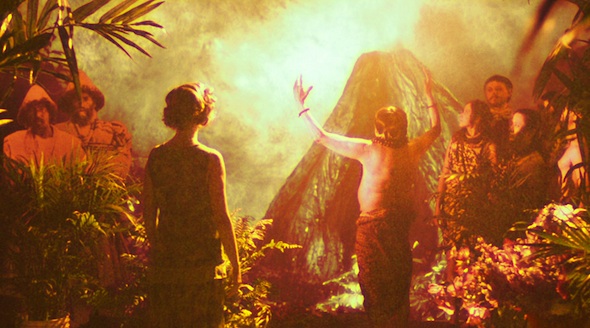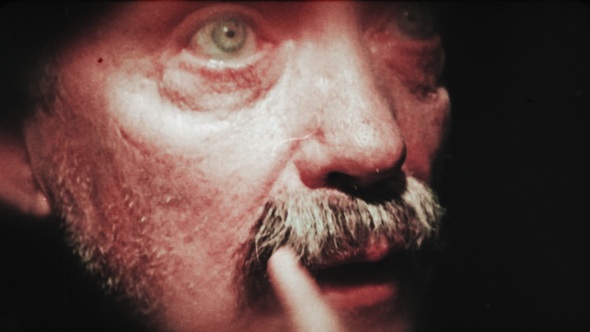Interview by Alison Hugill in Berlin; Tuesday, Mar. 03, 2015
Guy Maddin‘s latest cinematic venture, co-directed with longtime collaborator and fellow Winnipeger Evan Johnson, was screened as part of the Forum section of the Berlinale this year. The Forbidden Room stemmed from another project the pair are working on: an internet interactive called Séances, through which the directors resurrect lost films from the last century. Many of the scenes were shot in front of a museum audience at the Centre Pompidou in Paris and the Centre Phi in Montréal.
The feature-length film shows a collection of these heady narratives, artfully nested within one another like an interminable set of Russian dolls. Maddin’s latest film still contains much of his signature aesthetic and humour, but has reached new heights with a small team of young filmmakers and screenwriters working alongside him. After catching the final screening of the film at the Berlinale festival, Berlin Art Link spoke to Johnson and Maddin about their working process and the film’s reception on the festival circuit.
 Still from ‘How to Take a Bath’ in The Forbidden Room; Courtesy of Guy Maddin and Evan Johnson
Still from ‘How to Take a Bath’ in The Forbidden Room; Courtesy of Guy Maddin and Evan Johnson
Alison Hugill: The process for this film changed in some notable ways – you co-directed the film with Evan, and you shot entirely in digital rather than film. How did these changes affect the process for creating The Forbidden Room?
Guy Maddin: The writing process was also very different from my earlier films. Before, I would be transcribing a certain feeling I had, a bittersweet feeling about a recurring dream of a lost father. I would just write a draft, often with the help of my, at first, story editor and then full screenwriting collaborator George Toles. We’d write a draft and then I’d really spend a lot of work prepping the production design and casting. I was inspired by the homemade films of George Kuchar or early John Waters. The scripts weren’t worked over a lot, they never had a second draft. They were just autobiographical episodes. By the time we got to My Winnipeg in 2007, I spent a lot of time daydreaming about my relationship to my city, while out for walks with my friend Noam Gonick, and especially my dog Spanky. There’s something about walking that gets me thinking backwards in time. It was a very self-centred process and I always considered the script a starting point for something else.
But as Evan, Bob Kotyk and I started up on this project – after the first stage, eighteen days of shooting in Paris – we realized these scripts really had to be written tightly. The Forbidden Room started out as an internet interactive so it’s featuring a lot of short films, which were our original adaptations (if you can say that) of long lost movies from various corners of the globe.
 Still from ‘The Forbidden Room’, Directed by Guy Maddin and Evan Johnson; Photo courtesy of the directors
Still from ‘The Forbidden Room’, Directed by Guy Maddin and Evan Johnson; Photo courtesy of the directors
AH: You had originally based the concept on Raymond Roussel’s method of nesting stories within stories.
GM: Yes, we’d been talking about this as early as 2010. We had a lot of these stories already tightly written and meant to be used as moving parts and fragments in this internet interactive but later we started fitting them together. Each section was written on its own and then adjusted to fit into a feature film. I doubt many feature films have been written with so much attention paid to individual sections while ignoring the rest.
Evan Johnson: My role on the film was largely the same as Guy’s. At first, as a research assistant, I was eager to think through the problems we might have, given that it was going to be on the internet. I don’t think it’s because I’m younger, and I know the internet better or anything… I was just enthusiastic about the project.
GM: We think differently. You thought more conceptually and you came up with a lot of ideas that justified the existence of the internet project as an internet project. I, meanwhile, was just treating it like a bunch of film stuff that happened to be on the internet.
EJ: Yes, I was thinking about questions like: “What’s wrong with the internet?” Questions that don’t have answers but might generate some ideas, even within stories, and the way stories would bump into each other. These things affected the final feature as well, maybe in an annoying way.
GM: We were stubbornly going with internet experiences that will be much longer than the average internet experience. We’re sort of saying ‘Fuck the impatience of the internet!’
EJ: As someone mentioned to me, there’s a point in the movie where the viewer might feel like it will never end. It’s hard to see, the first time, that the narrative has a logical finishing point. Narratives just keep opening up and none of them are resolving and you think it might go on forever. We’re capturing that annoying or worrisome quality in the generative film, where the audience experiences panic. Bladder-panic.
GM: Evan thought of a really neat idea recently, so I will brag on his behalf. He suggested that every time a visitor to our interactive watches a film experience, it should then be destroyed and lost forever. It’s a commentary on the lost films.
AH: It sounds like the Snapchat of the arthouse film world.
EJ: I like the idea of this fleeting consciousness, maybe it will help the internet move more enthusiastically towards pure phenomenological experience.
 Still from ‘The Forbidden Room,’ Directed by Guy Maddin & Evan Johnson; Photo courtesy of the directors
Still from ‘The Forbidden Room,’ Directed by Guy Maddin & Evan Johnson; Photo courtesy of the directors
AH: Let’s talk about the so-called ‘irksome’ gender politics of the film. One reviewer described it well: “Maddin’s pure and peerlessly florid sense of melodrama […] here becomes a mechanism for foolhardy and paranoid men to ruin their lives as they attempt to rescue, love, or murder the beautiful women who didn’t ask for their help.”
EJ: Well, my first response is what sounds like an excuse, but it isn’t that: we’re basing the scripts off of mostly silent film synopses and melodramatic types. They’re usually films from the 1920s, and the ones that appealed to us often involved a story between a man and a woman. So the gender politics were … I wouldn’t say ‘charmingly retrograde’ but they were markedly of another time. It’s not like I look at Hollywood movies today and think we’ve made vast improvements. In these lost films, there were archaic types of marriages, and men were of a type and women were of a type. We were certainly interested in playing with that. The movie is full of men chasing and meddling with women.
GM: And we’re all men – we’re writing about what we know about. Especially me. I’ve had a longer history of being a man. They’ve probably only had 12 or 13 years, while I’ve been a big invertebrate man for decades now and I’ve finally figured out certain patterns. I came of age in the middle of fantastic second wave feminism. I bought all the ideology and then probably just went right on being as sexist as everyone else. Though I loved all the ideology, as almost a kind of fan.
AH: The way I see it, there’s a psychoanalytic, almost Freudian-style misogyny going on in many of your films, that is so self-aware and self-depricatingly neurotic that it can only be comical.
GM: I’m glad you think that. That’s very close to where we’re going. I like what Luis Buñuel does. He may have been a big sexist, traditional Spaniard for all I know, but in his movies I like the way he eviscerates his male characters. Even if the women remain mysteries to the male characters, and therefore also just barely sketched out for the viewers, the men default themselves to a ridiculous position by their actions. I do know what it’s like to be a man compelled by libido and heavily hard-wired romantic notions and traditions. I’ve experienced so many humiliations that are all my own fault and I’ve annoyed a lot of people over the years.
EJ: This kind of melodramatic trope happens in a lot of the movies, but not all of them. We had a lot of other stories that didn’t end up in this particular feature – stories that we had made for the interactive project. These stories have inverted variations of this, where female desire comes in for similar mockeries or where there are utopian matriarchies. It wasn’t our main obsession, but self-ridicule was part of the motivation for writing often.
GM: I felt safer when I was writing about my own experiences and my own feelings, and then ridiculing them. I just felt safer.
EJ: We wanted it to be a safe place… for us. [laughter]
 Udo Kier in ‘The Forbidden Room,’ Directed by Guy Maddin & Evan Johnson; Photo courtesy of the directors
Udo Kier in ‘The Forbidden Room,’ Directed by Guy Maddin & Evan Johnson; Photo courtesy of the directors
AH: I personally found your film hilarious – endlessly witty from the opening ‘How to Take a Bath’ scene. The humour was very familiar to me, as a fellow Canadian and fan, but I didn’t see the same reaction from the audience at the Berlinale.
EJ: I’ve heard that a comedy playing at the Berlinale won’t get as many laughs. Well, our film got the most walkouts at Sundance, but it also got far more laughter.
GM: Yea, people at Sundance were laughing over their shoulders as they walked out. [laughter] I think this movie is funnier than any of my earlier work. But my earlier stuff, which isn’t entirely different from this, has never been famous for having more than one or two people laugh at once.
I feel good about the way the movie has been received. The press has been really good, the audience has been really enthusiastic. I guess the movie comes with built-in commercial limitations galore but I think it’s something we stand a good chance of being proud of a few years down the road.
The Forbidden Room — a living poster from Guy Maddin on Vimeo.
___________________________________________________________________________________
Additional Information
THE FORBIDDEN ROOM
Directed by Guy Maddin and Evan Johnson
See website HERE
___________________________________________________________________________________
Alison Hugill has a Master’s in Art Theory from Goldsmiths College, University of London (2011). Her research focuses on marxist-feminist politics and aesthetic theories of community, communication and communism. Alison is an editor, writer and curator based in Berlin. www.alisonhugill.com






















